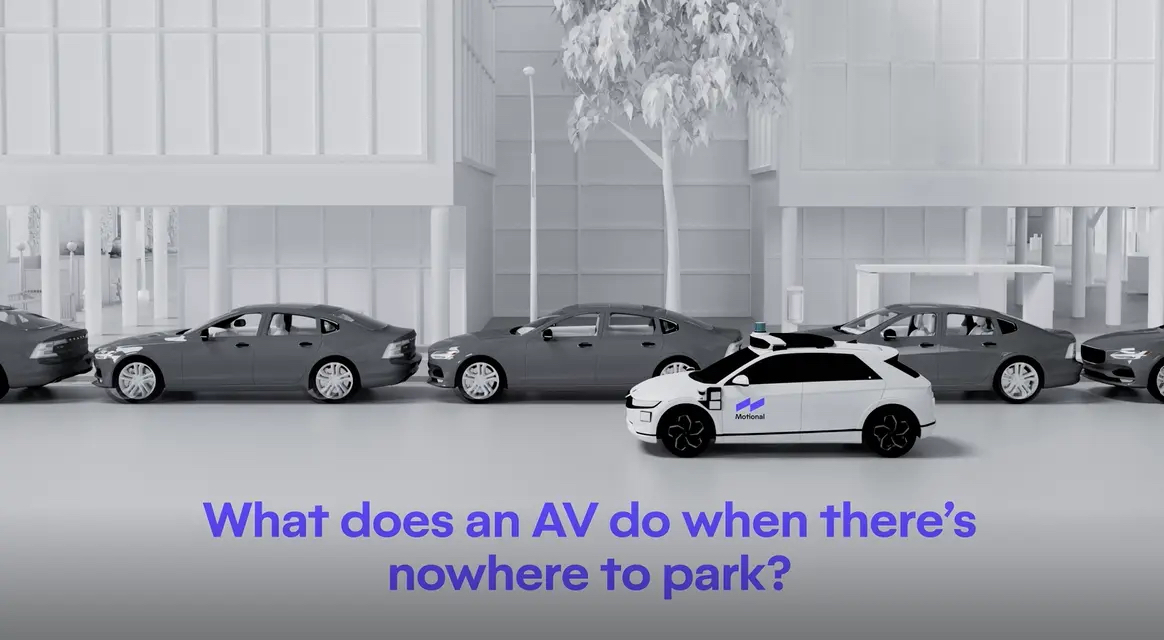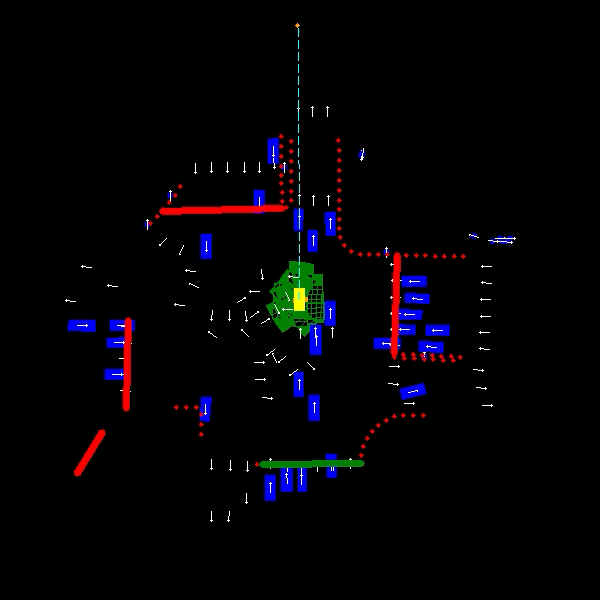- Cities should create designated curbside pickup and dropoff spaces for autonomous vehicles in commercial districts, with the number determined by data and demand.
- Human drivers can choose to ignore parking rules, including blocking fire lanes and double parking – AVs are required to follow the rules of the road.
- AVs may have trouble attracting repeat riders who feel inconvenienced having to wait for a driverless vehicle to circle around looking for a legal spot to pull over.
- By removing this competitive disadvantage, cities can receive the full benefit of AVs: safer roadways, reduced demand for long-term curbside parking, and more transportation options for residents.
Vehicles that follow the rules of the road? This benefit is one reason transportation planners and policymakers find the prospect of autonomous vehicles so intriguing. No speeding. No road rage. Just safe vehicles on safer streets.
However, by strictly adhering to driving rules, AVs may sometimes place themselves at a competitive disadvantage compared to vehicles with human drivers; specifically when there’s a lack of available curbside parking.
To maximize passenger convenience during pickups and dropoffs, human livery and ride-hail drivers will pull over as close to the target address as possible. And if there isn’t available curb space, a driver often won’t hesitate to double-park, block a crosswalk, or pull into a red zone, which are all illegal but commonly accepted practices.
This isn’t an option for driverless vehicles, which are legally required to be programmed to follow traffic regulations. Faced with the lack of available curb space, driverless vehicles won’t double-park; instead they will continue down the road or circle around a block looking for a safe - and legal - place to pull over.
Without designated pickup and dropoff spots along city curbs, AVs will face challenges gaining traction with customers who are used to door-to-door service and may feel inconvenienced by longer walks or delayed arrivals while their driverless vehicle locates legal curbspace.
Motional’s data suggests that a city such as Los Angeles would only need to create a couple pickup/dropoff yellow curbs every few city blocks, with the actual frequency based on demonstrable data and demand. Doing so would unlock the full slate of benefits a mature AV fleet will generate for a community: safer roads, transportation alternatives for their residents, and more flexible streetscapes.

FOLLOWING THE RULES
Human drivers that break traffic rules are a growing problem on U.S roadways. In 2021, 11,780 people were killed in speeding-related crashes, a 5 percent increase over the year before, according to federal highway safety data. Alcohol-involved fatalities also jumped 5 percent last year, claiming more than 8,100 lives.
As traffic planners know, even ‘acceptable’ violations, such as double-parking, aren’t harmless, but instead have real and harmful impacts on traffic and safety. Double-parking can block traffic and force cars to maneuver unsafely around a stopped vehicle. Blocking a crosswalk or stopping in a red zone can obstruct sight lines and put pedestrians at risk.
But human drivers, especially those operating in dense urban districts, frequently weigh the risks (personal safety, blocking traffic, parking enforcement officials) against the benefits (passenger convenience) before deciding to disregard traffic codes. Even in jurisdictions when these traffic rules are enforced, some commercial delivery companies simply bake the price of parking violations into their business models, knowing they have little choice but to park illegally in busy downtown districts to efficiently deliver packages.
Driverless vehicles, however, are programmed to obey traffic regulations. AV companies like Motional program their vehicles this way because we are concerned about roadway safety and want our vehicles to operate safer than a human driver. This is also often a requirement from public regulatory bodies as a permitting condition: Follow the rules, or lose your operational permit.
We agree. All vehicles should obey the rules of the road. Doing so will make our roadways safer. But when cities don’t provide designated pickup and drop off spots, AVs quickly run up against a conundrum. Follow the law and spend time searching for spaces, even if it means being at a distinct competitive disadvantage – or allow vehicles to park illegally, further contribute to roadway safety issues, and run the risk of losing operational permits. Neither scenario is ideal.
SPACE SAVERS
For several decades, curbsides have been primarily a place to store empty personal vehicles. Depending on the local rules, vehicles can be left parked along a curb for just a few minutes, or a couple hours, or sometimes for days and weeks at a time. Meanwhile, commercial vehicles, from delivery trucks to ride-share vehicles, jockey for any remaining spaces to pull into briefly.
Transportation planners and AV companies should work together to designate curb space specifically for driverless pickups and dropoffs, including robtaxis and commercial delivery companies.
Motional has been testing its AVs in Los Angeles and we’ve analyzed curb space in 15 different commercial districts with varying amounts of demand for ride-hail service. Using data, we can estimate the number of pickup and dropoff requests in each of these areas during different hours of the day, as well as how long it takes for a ride to start once the vehicle indicates it has arrived (about 4 minutes). From this, we can estimate the number of dedicated pickup and dropoff spots that can meet the demand of the region.
At this scale, one PuDo space in a neighborhood with medium-to-high demand for ride-hail services, such as Korea Town in Los Angeles, could serve approximately 4 commercial blocks. Along Sunset Boulevard in West Hollywood, however, where peak demand is higher, a reasonable allocation of PuDo zones would be roughly two PuDo zones every three blocks. The length of the block, the intensity of peak-service demand, and mix of properties all factor into final estimates.
Other cities are already experimenting with this sort of arrangement. A March 2021 paper from Harvard’s Taubman Center detailed how Washington D.C., successfully used designated pickup and dropoff zones to relieve congestion caused by double-parked ride-hail vehicles in Dupont Circle.
BENEFITS FOR ALL
Curbs are public assets. They should be leveraged to provide the greatest benefit to the public. Setting aside a small percentage of curb space as pickup and dropoff zones for ride-hails and driverless delivery will create tremendous value for cities, particularly as robotaxis mature as a service, and as consumer behaviors shift.
Most notably, roadways will get safer. Motional AVs have driven more than 2 million miles in autonomous mode without a single at-fault accident. Robotaxi fleets will save lives and prevent injuries.
The availability of robotaxis will also allow people to reconsider their decision to own a private vehicle. One study determined that a full, mature fleet of robotaxis could cut private ownership in a densely settled urban city by as much as two-thirds. Our Consumer Mobility Survey found that 40 percent don't have access to reliable transportation alternatives. A future with fewer personal cars on the road also means cities could rethink their curb space and streetscapes. If more people choose to use robotaxis and leave their personal vehicles at home, cities can rededicate their curbs and streetscapes for other purposes, such as public spaces.
RECEIVING THE FULL BENEFIT
Robotaxi companies want to build driverless vehicles that are safe and follow the rules of the road. But in cities that lack designated curbside pickup and dropoff zones, doing so will put our vehicles at a competitive disadvantage and diminish the level of service available to riders. Instead of allowing just a single vehicle to remain curbside for hours, cities should create designated pickup and dropoff zones that allow multiple vehicles to briefly pull in and out, ensuring the valuable curbside real-estate is used efficiently, and they receive the full benefit of a future driven by AVs.

